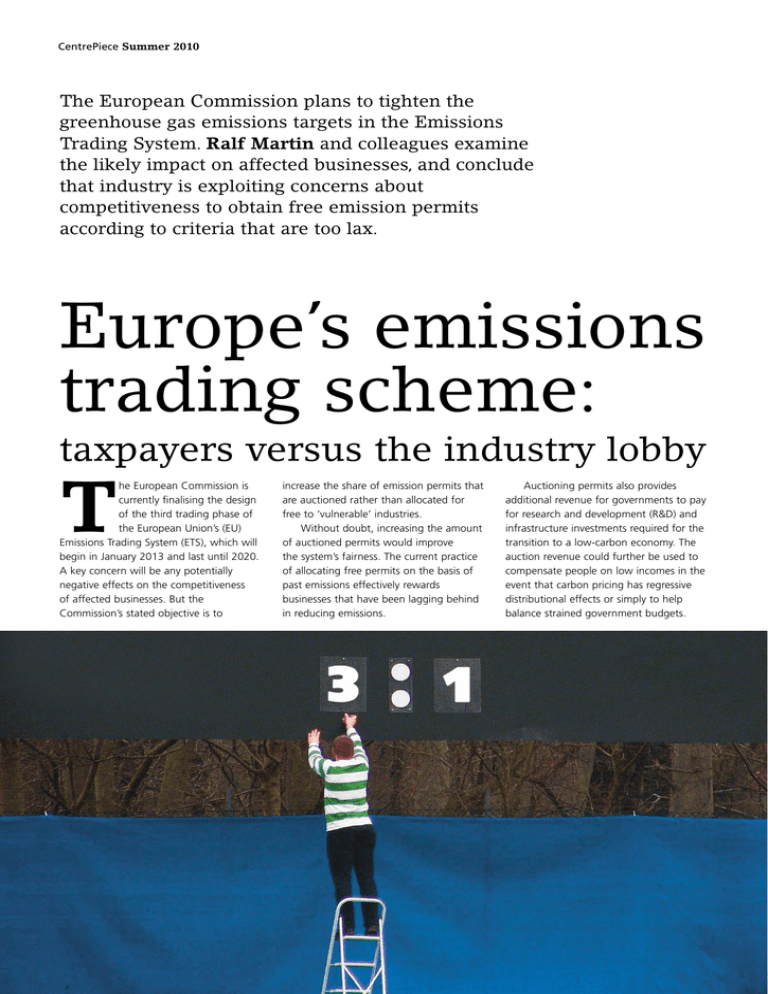Europe`s emissions trading scheme
advertisement

CentrePiece Summer 2010 The European Commission plans to tighten the greenhouse gas emissions targets in the Emissions Trading System. Ralf Martin and colleagues examine the likely impact on affected businesses, and conclude that industry is exploiting concerns about competitiveness to obtain free emission permits according to criteria that are too lax. Europe’s emissions trading scheme: taxpayers versus the industry lobby T he European Commission is currently finalising the design of the third trading phase of the European Union’s (EU) Emissions Trading System (ETS), which will begin in January 2013 and last until 2020. A key concern will be any potentially negative effects on the competitiveness of affected businesses. But the Commission’s stated objective is to increase the share of emission permits that are auctioned rather than allocated for free to ‘vulnerable’ industries. Without doubt, increasing the amount of auctioned permits would improve the system’s fairness. The current practice of allocating free permits on the basis of past emissions effectively rewards businesses that have been lagging behind in reducing emissions. Auctioning permits also provides additional revenue for governments to pay for research and development (R&D) and infrastructure investments required for the transition to a low-carbon economy. The auction revenue could further be used to compensate people on low incomes in the event that carbon pricing has regressive distributional effects or simply to help balance strained government budgets. CentrePiece Summer 2010 First, a complete relocation in response to carbon pricing is highly unlikely. Among the principal manufacturing industries we sampled, none of the ‘average’ firms are at risk of relocation or closure (see Figure 1). There is only one sector (Other Minerals) out of 14 where the average score is slightly above 3, implying downsizing by at least 10% of employment or output. In no case does the 95% confidence band include the maximum score of 5 (closure). The Emissions Trading System is accommodating the interests of the industry lobby too generously at the expense of European taxpayers Average risk of downsizing due to more stringent carbon policy’ Closure or relocation Downsizing of 10% Some impact Machinery and Optics Fabricated Metals Other Basic Metals Iron and Steel Other Minerals Cement Ceramics Glass Chemical and Plastic Fuels Publishing Wood and Paper Textile and Leather No impact Food and Tobacco The proposed design of the third phase of the ETS includes criteria to determine which industrial sectors should continue to receive free permits. Under these criteria, 147 sectors – more than half of the 258 manufacturing sectors under consideration – will be eligible for free permits, despite the fact that not all of these sectors include firms that are regulated by the ETS. This follows pressure from industry groups claiming that more stringent carbon pricing will provoke job losses and cause carbon-intensive production to relocate outside the EU – a process referred to as ‘carbon leakage’. Our research asks whether the proposed criteria for exemption from auctioning are appropriate. Do they capture the risk of downsizing or plant closure? And what are the implications in terms of job losses, carbon leakage and emissions? Our analysis is based on data from almost 800 interviews with managers in manufacturing plants – both members and non-members of the ETS – in six EU countries (Belgium, France, Germany, Hungary, Poland and the UK). Each firm is rated on a scale from 1 to 5 as to the likelihood and degree of downsizing in response to future climate policy, with a score of 1 corresponding to no expected response and a score of 5 indicating a high likelihood that the firm will close down or relocate. The results of the analysis are as follows: Figure 1: Notes: The bars show the sector-level average score measuring the risk of downsizing as a consequence of climate policy. The lines represent the confidence bands, calculated at the 95% level. Figure 2: Correlation between downsizing risk and intensity measures Carbon intensity Fitted values Trade intensity Fitted values 5 4 Downsizing risk score Where the Emission Trading System is going wrong 3 2 1 -1 0 1 2 3 4 Notes: Each three-digit industry is represented by one green and one red point. The horizontal axis measures for red points normalised carbon intensity (VaS) and for green points normalised trade intensity (TI). The vertical axis measures the downsizing risk score derived from the interviews with managers. The two lines represent the fitted values for each set of points. 11 CentrePiece Summer 2010 Figure 3: Value at stake and trade intensity of sectors in the interview sample 80 Value at stake 60 Most industry sectors entitled to free emission permits would not close or relocate outside of the EU if they had to pay for permits 40 20 0 0 20 40 60 80 100 Trade intensity Notes: The figure plots the position of the sectors included in our interview sample in terms of the two criteria proposed for exempting sectors from auctioning of permits. The size of the circles is proportional to the number of firms in a given four-digit industry (NACE 1.1 classification). The rectangles A, B and C represent the three sets of eligible sectors defined by the Commission’s thresholds for the two criteria. The solid lines show mean trade and carbon intensities, and the dotted lines represent the respective employment-weighted means. Figure 4: Impact measures across ‘at risk’ groups Closure or relocation Downsizing of 10% Some impact Second, the Commission’s assessment criteria are flawed. The Commission bases its assessment of sectors at risk of carbon leakage on two statistics – the carbon intensity (which is measured as the amount of carbon a sector emits divided by its value added; what is usually referred to as Value at Stake, VaS); and the trade intensity (TI), which the Commission defines as the value of imports and exports to non-EU countries over the total market size of the sector within the EU. We examine how well these statistics capture downsizing risk by correlating them with our score. Plotting sectoral carbon and trade intensities against downsizing risk scores reveals that carbon intensity is strongly correlated with downsizing risk, but trade intensity is not (see Figure 2). Using the trade intensity criterion to determine which sectors should be exempt from auctioning is therefore likely to result in exemptions for firms that are not at all at risk of downsizing or carbon leakage. Free permit allocation in this instance is simply a transfer of taxpayers’ money to industry without any additional social benefit – this money should be reclaimed. Notes: The bars represent, for each set of firms as described on the horizontal axis, the average score measuring the risk of downsizing as a consequence of climate policy. The lines represent the confidence bands, calculated at the 95% level. 12 C B & VaS>5 B & VaS<5 A Not exempt No impact Third, up to 88% of manufacturing sector emissions are exempt from regulation under the proposed thresholds for the ETS. The thresholds proposed by the Commission implicitly define three groups of exempted sectors, depicted as the rectangles A, B and C in Figure 3. Strikingly, group B contains a particularly heterogeneous group of industries. CentrePiece Summer 2010 There are a large number of industries with very low carbon intensity as well as a few sectors with moderate carbon intensity. We thus further subdivide this group by carbon intensity and analyse the following four subgroups: Group A with carbon intensity (VaS) greater than 30%. Group B with moderate carbon intensity, depicted as Group B & VaS>5%. This group has trade intensity (TI) greater than 30% and carbon intensity between 5% and 30%. Group B with high trade intensity (>30%) but low carbon intensity (<5%), depicted by Group B & VaS<5%. Group C with moderate trade and carbon intensity (5%<VaS<30% and 10%<TI<30%). Figure 4 plots the average downsizing risk and associated 95% confidence bands for these groups. Only carbon-intensive firms (Group A) and the more carbon-intensive among the trade-intensive firms (Group B & VaS>5%) are at high risk of outsourcing a significant part of their production – but even then the downsizing is only around 10%. revenue for European governments of at least €7 billion annually. This article summarises ‘Still Time to Reclaim the European Union Emissions Trading System for the Taxpayer’, a CEP policy Changing criteria moving forward briefing by Ralf Martin, Mirabelle Muûls and We find no evidence that the trade intensity criterion reliably measures the risk of downsizing or closure across sectors. The Commission should therefore replace this criterion in the longer run with one that more accurately reflects a sector’s vulnerability to carbon leakage. The trade intensity measure potentially misses an important aspect that determines vulnerability – namely ‘locational specificity’. The more strongly a firm benefits from factors that are specific to the EU – such as the skill set of the workforce, agglomeration economies, the stability of institutions, etc. – the less likely it is to shift production abroad in response to EU climate change policy. Nevertheless, more research into the measurement of locational specificity is needed before this concept can be implemented. download/pa010.pdf). Ulrich Wagner (http://cep.lse.ac.uk/pubs/ Ralf Martin is a research economist at CEP. Mirabelle Muûls is a research associate in CEP’s globalisation programme and at the Grantham Institute for Climate Change at Imperial College London. Ulrich Wagner is at Universidad Carlos III de Madrid and is a research associate in CEP’s productivity and innovation programme. Further reading Barry Anderson, Jörg Leib, Ralf Martin, Marty McGuigan, Mirabelle Muûls, Laure de Preux Conclusion and Ulrich Wagner (2010) ’Climate Change Despite many design improvements, there is a concern that even in the third phase of the ETS, the Commission is Policy and Business in Europe — Evidence from Interviewing Managers’, forthcoming CEP Discussion Paper. Removing the exemptions in the Emissions Trading System would raise €7 billion annually How to save €7 billion If the Commission’s exemption criteria were to exclude only these two groups (A and B & VaS>5%) from permit auctioning, the amount of permits auctioned would increase considerably without aggravating the overall risk of job losses and carbon leakage. This could be achieved by modifying the thresholds for the third phase of EU emissions trading as follows. Only sectors with a carbon intensity higher than 30% or sectors with both trade intensity greater than 10% and carbon intensity of more than 5% should be granted an exemption. This modification would revoke the exemptions currently envisaged for Groups C and B & VaS<5%. By a conservative estimate, this would provide additional accommodating the interests of the industry lobby too generously – at the expense of European taxpayers. But there is still a window of opportunity for European governments to improve the design of the ETS while raising additional income of €7 billion annually. Rather than providing an unspecific subsidy for industry, this money could be earmarked to finance investments and R&D crucial for the transition to a lowcarbon economy. It could equally be used to mitigate the possibly regressive effects of higher carbon prices on low-income groups. Finally, it could help to balance strained government budgets in the wake of the financial crisis. 13




